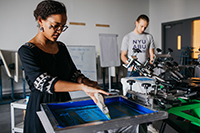The Light-1 CubeSat has successfully launched into space with the help of a team from NYU Abu Dhabi composed of students, staff, and faculty members.
Working as part of a collaboration among the UAE Space Agency, Bahrain’s National Space Science Agency, and Khalifa University of Science and Technology, the NYUAD team helped successfully launch Light-1 into orbit from the International Space Station, in cooperation with the Japan Aerospace Exploration Agency (JAXA).
The NYU Abu Dhabi team of four Emirati students (Ahlam Alqasim, Fatema Alkhouri, Aisha Almannaei, and Noora Almarri), five international students (Sebastian Kalos, Rodrigo Torres, Mimi Filova, Eddie Han, and Silviu Udrescu), and an Emirati staff from the Kawader Program, Lolowa Al Kindi, worked on the development of the payload called Rapid Acquisition Atmospheric Detector, abbreviated RAAD meaning Arabic for thunder. The project was carried out under the guidance of Program Head of Physics Francesco Arneodo and Professor of Physics Mallory Roberts.
The Light-1 CubeSat represents the region’s first scientific mission to monitor and study Terrestrial Gamma-ray Flashes from thunderstorms and lightning. Data gathered from the Light-1 CubeSat, which aims to leverage space science to support sustainable economic growth, will be shared globally to support scientific analysis and encourage cooperation with research centers around the world.
The impact of high-energy gamma-ray emissions on atmosphere, air traffic and human health, especially flight crews, will be studied by Light-1. These rays can penetrate aircraft structures, and therefore the data of Light-1 will improve understanding related to radiation exposure.
Light-1’s gamma-ray detection system RAAD, designed and assembled with a unique layout, and making use of state-of-the-art detection devices, is competitive with bigger satellites and can make an impactful contribution to the comprehension of TGFs. Thanks to its innovative technology, the Light-1 nanosatellite might become a pathfinder of future and larger missions targeting gamma rays.
RAAD makes use of ‘scintillating’ crystals, the material that emits light when crossed by a subatomic particle, specifically chosen for their quick response time. The light emitted by the crystals is collected by photomultipliers and processed by a dedicated electronic system. The different types of crystals, together with the custom-designed electronics, make RAAD a unique detection system.
“We hope that the satellite will provide new data on terrestrial gamma-ray flashes, and that scientists and people around the world will benefit from them,” Westermann said.
As part of the mission that included the NYUAD, 22 Khalifa University students worked on the design and development of Light-1 bus under the guidance of Assistant Professor of Mechanical Engineering Firas Jarrar, who manages Yahsat Space Lab.
“The launch of Light-1 CubeSat into its orbit from the International Space Station reflects the intense collaboration engaged by all stakeholders involved, as well as the extent of technical brilliance displayed by students in the UAE with suitable guidance from experts. As this UAE-Bahraini nanosatellite reached its orbital position, we believe this collaboration initiative will stand out as the best example of what can be achieved by the scientists in the Arab world,” said Dr Arif Sultan Al Hammadi, Executive Vice-President, Khalifa University.
JAXA coordinated the launch from the Tsukuba Space Center (TKSC) in Japan, and the event was broadcast live.


